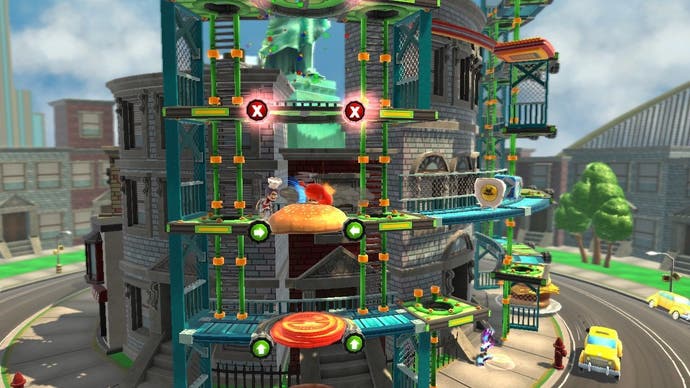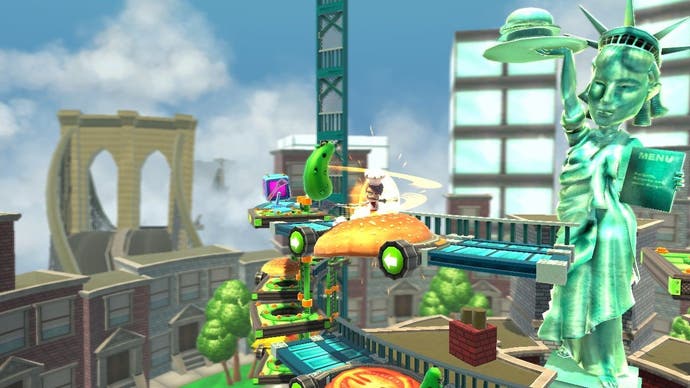BurgerTime World Tour Review
Block-dropping meats.
Good afternoon, class. Welcome to Arcade Gaming 101. Today we're going to compare and contrast two games, one from 30 years ago and the other its 2011 remake. To start, let's watch this short film.
That's the original BurgerTime, developed by Data East in 1982. A fairly craven combination of elements from more successful titles - notably Pac-Man, Dig Dug and Donkey Kong - the aim is to assemble burgers by dropping the ingredients down a series of scaffolds. You do this by walking over the buns, lettuce, cheese and patties. Once you've walked the entire length of an ingredient, it drops to the next level down. Even by 1980s standards, that's a flagrant abuse of hygiene laws.
If there's another ingredient directly below, that one gets knocked down a level as well, and so on, creating a calorific cascade until the burger is complete. One-hit-kill enemies such as hot dogs, fried eggs and pickles roam the level, and can be stunned with pepper or killed by ensuring they're on, or under, an ingredient when it falls. Ingredients carrying an enemy fall further, racking up the big scores.

This basic template has been carried over to the 2011 version, but developer Monkey Paw has made all the typical mistakes of a modern studio "enhancing" an ancient game.
For one, it's now 3D, with levels that revolve around as you explore. It's a terrible decision, as it means that not only does finding and reaching the ingredients become a joyless chore, but enemies and obstacles can now be easily missed thanks to the screwy perspective. Vague collision detection and a generally busy colour palette also play their part in ensuring most of your lives won't be lost through mistakes on your part. The original game was a one-screen affair through necessity, but that's why it worked. You could see exactly where every ingredient and enemy was at all times, and could plan and react accordingly. Not any more.
Control is also an issue, with analogue movements that leave your chef (either an in-game character or your Xbox Avatar) skidding a few pixels too far after you let go of the stick. This sort of game requires very rigid movement parameters, something that is contrary to the flexibility of modern directional sticks, and as such you never feel fully in control.

And finally, the game introduces a parade of new power-ups, traps and other trinkets in a misguided attempt to spice things up. Nobody played the original BurgerTime thinking it needed jet packs (anymore than people played Jetpac and thought it needed burgers), but here the game delights in introducing more and more elements, swamping the simplicity of the original in garish and often pointless clutter that distracts rather than embellishes.
There's no point getting too outraged about indignities being heaped on something like BurgerTime. It was hardly a classic even in its heyday and was always, at best, a decent distillation of the superior games that came before it. But it was developed with a keen understanding of what the hardware could do, and its gameplay works - and still works today - because it works within those boundaries.
By retaining that basic gameplay but changing everything else, BurgerTime World Tour is stuck between two distant generations, losing the clarity of purpose of the arcade original but doing nothing to make the concept fit into a modern design framework. Put simply, it's just not fun.
Like the best burgers, the best arcade games are simple, allowing us to enjoy the important flavours. BurgerTime World Tour is like a child sticking everything they can find between two halves of a bun, and then gorging on the resulting mess until they puke. Bon appetit.

